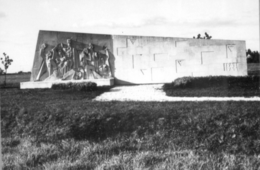Forced Labour on the Jalaka Line
How anti-tank trenches were dug on the Jalaka line to protect against German invasion in the summer of 1941.
How the anti-tank trenches of the Jalaka Line were dug to defend against the German offensive in summer 1941.
To avoid being sent to the dig, many clever, gritty people pretended to be going to or to have just come from the digging, carrying a shovel when outside. Some women took their children with them when heading outdoors so as to avoid being sent to the trenches. In time these measures no longer helped, as the deadline was approaching and wherever there were people roaming in the streets, they were immediately taken and put to work, be they barely clothed or empty-handed, despite them officially being ordered to bring three days’ worth of food with them. Some of the trenches needed to be completed in such a hurry that people were snatched from their homes mid-meal, or while dressed in swimsuits and bareheaded and barefoot. The day shift started at six in the morning and lasted until six in the evening. Then the night shift started, lasting from six in the evening till six in the morning. Every 80 minutes there was a 10-minute smoke break. A mere half-hour was provided for eating. Many had not had the chance to bring anything to eat with them and had to work on an empty stomach.
Forced labor on the Jalaka route. Postman. 7/1/1942 https://dea.digar.ee/cgi-bin/dea?a=d&d=postimeesew19420701.2.27
Related topics
Related objects
Tartu Anti-Tank Line – Jalaka Line
The Jalaka Line (named after the Chairman of the Executive Committee of Tartu, Kristjan Jalak) was an anti-tank trench dug alongside the Riga road near the village of Räni four kilometres outside of Tartu in summer 1941 as a countermeasure against the German offensive.
Part of the line is situated in Lemmatsi, another village outside of Tartu by the E264 towards Valga. The other part was established on the right bank of the Emajõgi River stretching from Kärevere to Praaga.
Citizens of Tartu aged 16-55, men and women alike, were forced by the Soviet regime to construct the fortifications for the Jalaka Line. The German regime used the trenches in 1941 and 1942 to execute those in its Tartu concentration camp who had been sentenced to death. During the Soviet era a monument was erected, designed by Elmar Rebase and Väino Tamm, in memory of the victims of terror.





